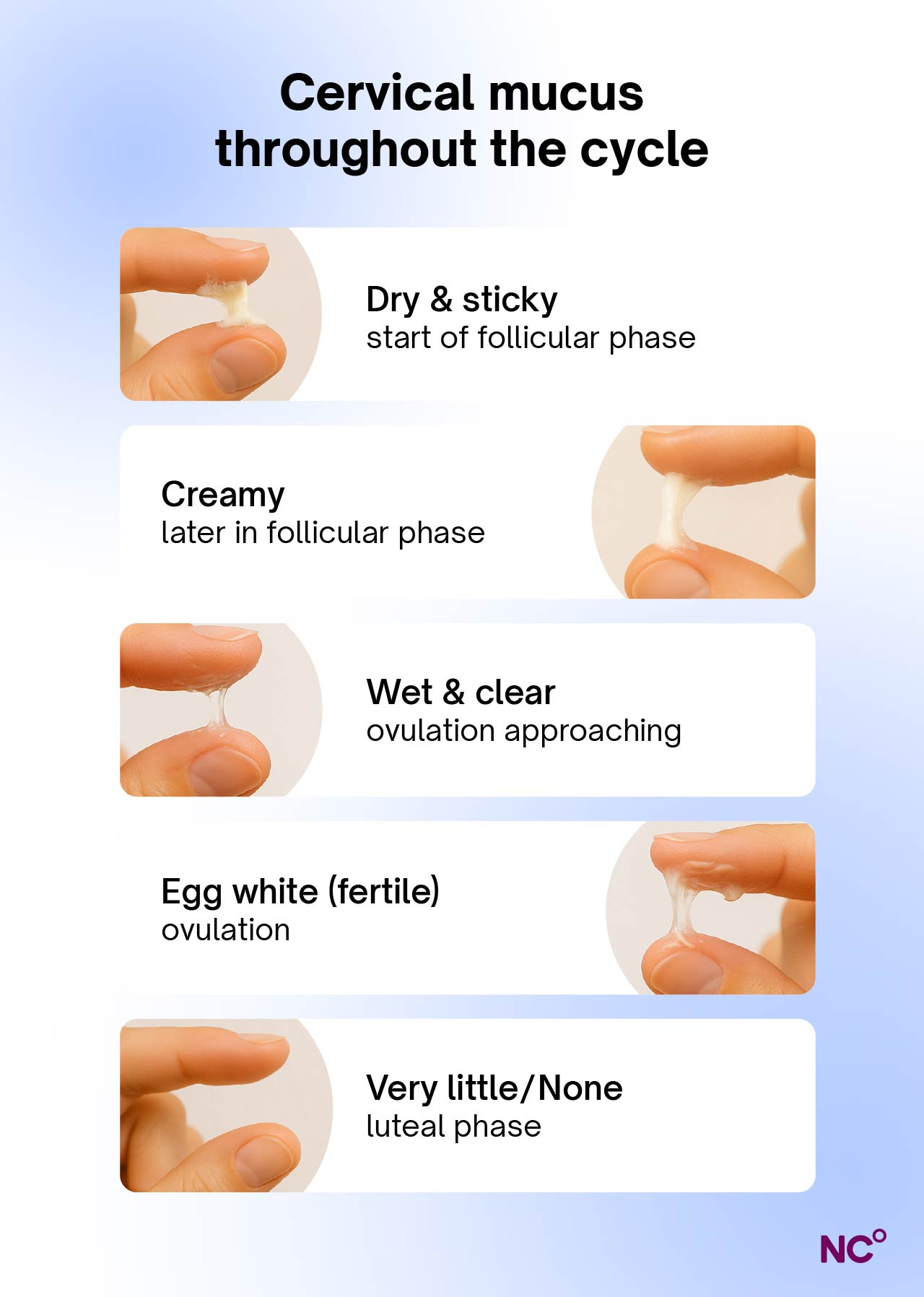Cervical mucus: What is it, different types, and what it means
Follows NC° Editorial Policy
At Natural Cycles, our mission is to empower you with the knowledge you need to take charge of your health. At Cycle Matters, we create fact-checked, expert-written content that tackles these topics in a compassionate and accessible way. Read more...
Key takeaways
- Cervical mucus is a natural fluid that forms in the cervix and gets secreted out via the vagina throughout the menstrual cycle
- Depending on what phase of the cycle you’re in, your cervical mucus will vary in consistency, color, texture, and more
- Tracking these changes over time can help you identify patterns and figure out the timing of your cycle phases, including your fertile window
On this page
- What is cervical mucus?
- How does cervical mucus change throughout my menstrual cycle?
- Checking cervical mucus
- What’s the Cervical Mucus Method?
- Signs of pregnancy in cervical mucus
- Does hormonal birth control affect cervical mucus?
- What can cause changes to my cervical mucus?
- Track your cycle symptoms effectively with Natural Cycles
Cervical mucus plays a key role in our reproductive health. Also called cervical fluid, cervical mucus is a substance that forms in the cervix and is secreted through the vagina. It can provide all kinds of indications about your health, fertility, and more. In this article, we’ll go over the different types and stages of cervical mucus you can expect during your cycle, what the Cervical Mucus Method is in relation to natural family planning, plus how cervical mucus symptom tracking can help you learn more about your body.
What is cervical mucus?
Cervical mucus is a bodily fluid that is formed and secreted by the cervix. Its production is stimulated by increasing levels of estrogen in the body during each menstrual cycle. Since estrogen levels vary throughout the cycle, the amount, consistency, and even color of your body’s cervical mucus will also change throughout your cycle. Observing these changes over time with Natural Cycles can help you identify your unique cycle patterns [1].
What can cervical mucus tell you about your health?
Cervical mucus can give you clues about your fertility, particularly the timeframe when you’re most fertile. It’s a good indicator of your most fertile days when you’re most likely to conceive. During this time, your cervical mucus will have a unique consistency and color.
The mucus can also be an indicator of your libido (sex drive), which may change throughout your cycle depending on which phase you’re in. Major, unusual changes in your cervical mucus, like foul smells or a green color, can signal a more serious underlying condition like an infection. See a healthcare professional if you notice these unusual shifts [2].
How does cervical mucus change throughout my menstrual cycle?
Let’s go over the most common ways cervical mucus changes over the course of a menstrual cycle:
|
Cycle phase |
Cervical mucus characteristics |
|
After your period |
This is when your body will produce the least amount of cervical mucus, and you may feel “dry.” If you do have any discharge, it will likely feel “sticky.” |
|
Approaching ovulation |
As you approach and enter your most fertile days, you’ll notice an increase in the quantity and moistness of your cervical mucus. It will likely look and feel a bit “creamy,” and may also be cream-colored. |
|
Around ovulation |
During ovulation, your body will produce the highest amount of cervical mucus. It will feel quite “wet” or slippery, and it will be thin and stretchy. It’ll resemble egg whites in color and consistency. |
|
After ovulation |
At this time, your body will produce less cervical mucus. It will also become slightly thicker in consistency until your period. You may also have a few “dry” days right before your period. |
What does your discharge look like when you are ovulating?
Your cervical mucus will appear similar to egg whites in both color and quality in the days around ovulation. It will be almost clear, thin, stretchy, and slippery — very similar to egg whites. This happens because estrogen is surging, causing these changes in the mucus to create an environment that is more welcoming to sperm cells in terms of both texture and pH [1].
How many days before ovulation do you get egg white mucus?
You’ll start to see egg white discharge a couple of days before ovulation. While this will likely be the ~6 days around ovulation, this timeframe can vary from person to person [4]. The best way to predict when egg white mucus will happen each cycle is to check and track the quality of your cervical mucus over time to identify your unique cyclical pattern.
Checking cervical mucus
Now that we know what changes to be looking out for, you may be wondering how to tell that these changes are happening. It’s very common to find cervical mucus discharge in your underwear, or when you wipe using the toilet, so you may notice these changes in your cervical mucus in those ways.
If you really want to be sure you’re getting an accurate picture of your cervical mucus, the most accurate way to identify these changes is to collect and observe a sample of the mucus on a daily basis with your fingers. To do this, first you’ll wash and dry your hands thoroughly. Then, you’ll insert your middle and/or index finger into your vagina, getting up and as close to the cervix as possible. When you remove your fingers, you’ll have a sample of the mucus. To assess the quality, you can roll it in between your fingers, or press your fingers together and slowly move them apart [1].

What’s the Cervical Mucus Method?
The Cervical Mucus Method is a way to naturally identify your most fertile days each month. You’ll use all the information outlined above — collecting a sample of your cervical mucus each day and noticing the quality, consistency, and color. Then, you’ll log these qualities on a calendar to identify the patterns over time, particularly your fertile window. To simplify the logging process, you can label the days as “dry,” “wet,” or “sticky.” “Wet” days will probably be when you’re most fertile, and when conception is most likely [3].
If you’re using Natural Cycles to track your fertility, you’ll have the option each day to add the amount and consistency of your cervical mucus. You can then compare this easily from day-to-day and cycle-to-cycle to learn more about your body.
What are some limitations of the Cervical Mucus Method?
The Cervical Mucus Method can give you a good idea of your patterns and fertility, but it’s not perfectly reliable. The qualities of cervical mucus can be hard to identify and distinguish without practice, and may require dedicated training [5]. It’s also possible to misinterpret cervical fluid as sexual secretion (the body’s natural lubricant), or even residual semen from sex [3].
Furthermore, women who are breastfeeding, taking hormonal birth control, have vaginitis or sexually transmitted infections, or who have had cervical surgery shouldn’t rely on this method, as all of these conditions may affect the characteristics of cervical mucus [3, 4].
This is why Natural Cycles uses more objective measurements — basal body temperature readings, period dates, and optional luteinizing hormone tests — to identify your fertile window.
Signs of pregnancy in cervical mucus
You may be wondering if there are any noticeable changes in your discharge after ovulation if you’re pregnant. While it’s normal to have more discharge than you normally do during pregnancy, this increase typically doesn’t start immediately.
Cervical mucus in early pregnancy
You’ll still have cervical mucus and discharge in early pregnancy, but any changes here are typically not a great indication of early pregnancy [6]. The only surefire way to tell if you are pregnant is with a pregnancy test.
Cervical mucus later in pregnancy
As the pregnancy progresses, you will start to notice more cervical mucus than you’re used to. The reason why we have higher amounts of discharge during pregnancy is to help prevent infections from traveling up the vagina to the womb to protect the pregnancy. This increase happens gradually during the pregnancy until the last week or so. At this point, you may notice discharge that contains streaks of sticky, jelly-like pink mucus. This is often referred to as a “show,” “bloody show,” or “mucus plug” and indicates that you’re near the end of the pregnancy journey [6].
Does hormonal birth control affect cervical mucus?
More research is needed in this area, but we do know that cervical mucus is affected by the hormone levels in your body, particularly estrogen. Taking hormonal birth control will affect the natural hormones already present in your body, so it’s likely that hormonal birth control does affect cervical mucus as well. We just don’t know exactly how, although researchers are currently investigating this [4]. An analysis including the results of three different sub-studies found that people who used hormonal birth control had a less predictable cervical mucus pattern overall [7].
What can cause changes to my cervical mucus?
As we mentioned earlier, breastfeeding, having vaginitis or sexually transmitted infections, or a history of cervical surgery can all affect the characteristics of cervical mucus.
Outside of these conditions, other factors like diet, stress level, or taking certain prescription medications like Clomid can also affect your cervical mucus, particularly in terms of the amount your body produces each cycle [1].
Track your cycle symptoms effectively with Natural Cycles
Cervical mucus is just one indicator of your fertility and cycle patterns. Using Natural Cycles, you can harness the power of these symptomatic changes along with your basal body temperature to get the full picture of your reproductive health. See if Natural Cycles can help you learn more about your body today.
Did you enjoy reading this article?
